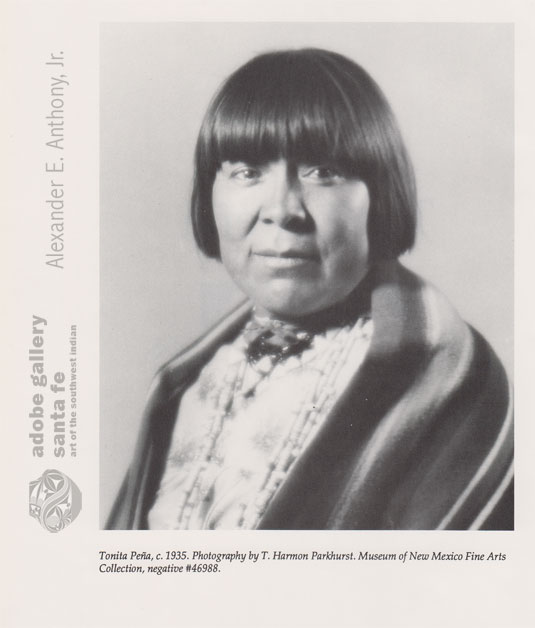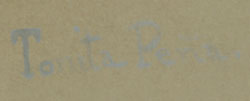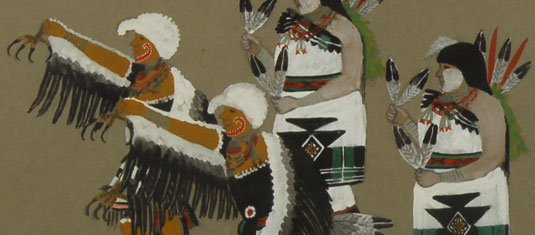Rare and Elaborate Painting of an Eagle Dance Ceremony [SOLD]
+ Add to my watchlist Forward to Friend
- Category: Paintings
- Origin: San Ildefonso Pueblo, Po-woh-ge-oweenge
- Medium: opaque watercolor
- Size:
11-1/2” x 21” image;
18-3/4” x 28” framed - Item # C3928N SOLD
 This is a most elaborate presentation of an Eagle Dance ceremony. It is opaque watercolor on paper and features two male and two female Eagle Dancers, six drummers, five singers, and two others, one with a black face and one with a white face. There are no other elements, such as ground plane, plants, or sky. The imagery is well balanced, with the drummers and singers grouped together on the right and the eagle dance group allowed more space on the left—an indication of their importance. Tonita had a unique talent for space relation and color coordination.
This is a most elaborate presentation of an Eagle Dance ceremony. It is opaque watercolor on paper and features two male and two female Eagle Dancers, six drummers, five singers, and two others, one with a black face and one with a white face. There are no other elements, such as ground plane, plants, or sky. The imagery is well balanced, with the drummers and singers grouped together on the right and the eagle dance group allowed more space on the left—an indication of their importance. Tonita had a unique talent for space relation and color coordination.
The Eagle Dance is performed in early spring and repeated from time to time during the summer. The eagle is believed to have direct intercourse with sky powers and is much venerated by the Pueblo Indians. The Pueblo Eagle Dance is a dramatization of the relationship between the eagle and man and supernatural powers. Generally, two young men, costumed as eagles, imitate, during the dance, almost every movement possible of the eagles. They replicate eagles soaring over the fields, perching on high places, and resting on the ground.
This painting is an excellent recording of an Eagle Dance by one of the most accomplished female painters of the 20th century from a New Mexico pueblo: Tonita Vigil Peña (1893-1949) Quah Ah.
Tonita Peña signed her paintings with varying signatures during her long career. It appears that her earlier paintings were signed with her baptismal or Christian name, Tonita Peña. She then chose to use her Tewa name, Quah Ah, which lasted until around 1915. In 1908, Tonita had married Juan Rosario Chavez, when she was 15 and he was 20 years old. Juan passed away three years later. Tonita then married Felipe Herrera in 1913 and, shortly afterwards, modified her signature to Quah AH, capitalizing the H in honor of Felipe. This signature lasted until Felipe passed away in 1920. After Tonita married her third husband, Epitacio Arquero, in 1921, she then changed her signature to Quah Ah or QuaH AH over Tonita P. Arquero, a signature that lasted until 1923.
 This painting is signed simply Tonita Peña. Tonita was the only woman in the group of talented early pueblo artists referred to as The San Ildefonso Self-Taught Group, which included such noted artists as Julian Martinez, Alfonso Roybal, Abel Sanchez, Crecencio Martinez, and Encarnación Peña.
This painting is signed simply Tonita Peña. Tonita was the only woman in the group of talented early pueblo artists referred to as The San Ildefonso Self-Taught Group, which included such noted artists as Julian Martinez, Alfonso Roybal, Abel Sanchez, Crecencio Martinez, and Encarnación Peña.
By the time she was 25 years old, she was a successful easel artist, and her work was being shown in museum exhibitions and in commercial art galleries in Santa Fe and Albuquerque. She painted what she knew best — scenes of life at the pueblo — mostly ceremonial dances and everyday events. She is still considered one of the best female Indian artists of all time. Her attention to accuracy of presentation of ceremonies and costuming in her subjects is one of her contributions to ethnologists who rely on her details for study.
Dorothy Dunn stated “Quah Ah’s art is an art of radiance and tranquility. It is possessed of delicacy and grace, and much music. It is unequalled at conveying the dignity, the serenity, the great earnestness and wholehearted sincerity of the Pueblo ceremonial and the Pueblo people. Quah Ah’s work is not ever spectacular or striking, but it is completely unpretentious and authentic. She might be called a conservative painter for she has set her own standards in keeping with tradition and has adhered to them through the years so consistently that, even beyond her death, she has never been superseded as the dean of Indian women painters."
Condition: appears to be in good condition.
Provenance: from the estate of a former client from New York
Reference: American Indian Painting of the Southwest and Plains Areas by Dorothy Dunn, UNM Press, 1968
Recommended Reading: Tonita Peña by Samuel Lewis Gray
Tonita Peña - Image Source: from the book Tonita Peña by Samuel L. Gray. Photo by T. Harmon Parkhurst. Museum of New Mexico Fine Arts Collection, negative #46988.

- Category: Paintings
- Origin: San Ildefonso Pueblo, Po-woh-ge-oweenge
- Medium: opaque watercolor
- Size:
11-1/2” x 21” image;
18-3/4” x 28” framed - Item # C3928N SOLD



